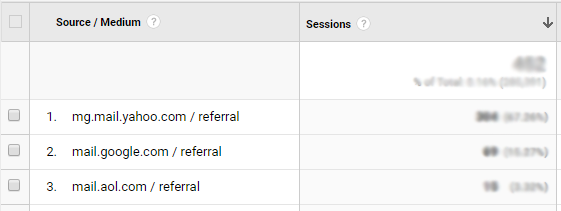Beginning a Google Analytics audit can feel like an impossibly long process. With numbers and charts that seem to go on forever, it can be a challenge to know where to even start. In order to survive the waves of data it’s important to stay focused on the task at hand so you can navigate your way through the most important areas. Regular health checks of Google Analytics account are necessary to ensure the accuracy and consistency of all analytic reports. Spending time finding potential problems now can save you from headaches and frustration in the future. So without further ado, let’s get this analytics party started.
Where to Start?
In order to stay on course, it is important to set up general goals for the audit. Four great questions that can help guide you through the process are:
- Is Google Analytics collecting the data we want/need?
- Can we fully trust the data being collected?
- Is there anything Google Analytics should not be reporting?
- Are we following Google Analytics best practices?
With these questions you can quickly come across data and decide if the findings help answer anyone of the questions. If the data found correctly answers a question, then you know Google Analytics is correctly collecting data for that report and you can move on to the next. For the most part this strategy allows demographic reports and other audience reports to be quickly sifted through, while Acquisition and Conversion reports may provide more relevant information for identifying issues in your Google Analytics account.
Quick Checks
Before diving in deep, it is important to make sure the basic settings for your Google Analytics account are correct. In short, be sure your account follows Google’s best practices. Checking admin setup and analytics implementation can be done quickly and painlessly.
Easy and a Breeze to do:
- Account Views – For best practices each account should have 3 views:

- Main View – As the name suggests, this will be primary view. This is where you find data for all reports and should be kept as clean as possible. Keep it professional and polished.
- Raw Data View – This is the untouched view, no filters or goals. The purpose of this view is to act as a backup in case other views become corrupt. I repeat do not touch!
- Testing View – In order to avoid data corruption a testing view is needed. This is the view you should apply new filters and goals to before adding them to the main view. Think of it as the playground.
- Timezone – While pretty straight forward, this setting is often overlooked and can skew how you analyze certain reports. First you must decide which is more beneficial for your reports, setting the time zone to your business location or having it set to the time zone where the website gets the most traffic. If the time zones are the same, then it is a pretty simple choice.
- Bot Filtering – While chatbots and all other robots can be a fun time, there is no room for them in a Google Analytics account. So make sure the box is check to block all of Google’s known scams.
- Site Search On – If a website has a search function, Google Analytics should be set to record user searches.The data collected from searching on your website can lead to new product ideas, navigation optimization and can help identify content gaps. And as the kid’s say, more data always means more fun.
Might Take a Little Elbow Grease:
- Analytics Code on All Pages – Screaming Frog is a great tool for finding this information. Adding your sites Analytics code to both custom filters of “Contains” and “Does Not Contain” before crawling the site will allow you to quickly see if any pages are missing the Analytics tag.
- Tip: Also include a “Does Not Contain” filter for “www.google-analytics.com/analytics.js” in order to insure the ending of the analytics code did not fall off on any page.
- Correct Filters – While each site is different, in general make sure your IP and other company IPs are filtered out of the results. Remember filter order matters.
Common Issues
While searching for all the unique issues in one Analytics account will take some time, there are a number of problems that constantly turn up in Analytic reports. Here are some of the more common and frequently cited problems.
- Problematic Custom Campaigns/UTM Parameters – For the most part UTM Parameters are used for email campaigns, but these tags can actually be used in a variety of creative ways. Using UTM tags correctly will go a long way with clean and correct Custom Campaign data. Instead of seeing email platforms in the Referral Channel, using parameters will allow Google Analytics to attribute traffic to whichever channel you deem necessary.

- Duplicate Transactions – Finding duplicate transactions is simple enough, all you need to do is create a custom report. To make things even easier, only two settings need to be chosen, one metric and one dimension. Under Metric Group select Transactions and under Dimensions Drilldown select Transaction ID. Now all you have to do is view the custom report. If there is more than 1 transaction for a specific transaction ID, then your Analytics account is reporting duplicate transactions. Unfortunately, duplicate transactions can result in incorrect revenue reports, along with other ecommerce reports that utilize this transaction data. Correcting this problem can be challenging and requires implementations on the server side or through modifications to Google Tag Manager.
- Personally Identifiable Information – You will need to go into the Behavior report to find out if your Analytics is collecting this type of data. To begin go to Behavior > Site Content > All Pages and within the search you’ll need to type in “/@”. This should pull any email addresses that have been collected within Analytics. Collecting personally identifiable information is against Google’s Terms of Service, so it is important to correct this issue as soon as possible.
Customization
Ultimately there is no one checklist for every Google Analytics Account. Checklists and the Google Analytics Help Center can be a big help, but the biggest insights will come from spending time with the data and playing with the different reports. Each website will face it’s own unique challenges when it comes to the war on data inaccuracy. Ecommerce sites may have issues with third party payment data, while local businesses might have problematic campaign goals and events.
The best strategy is to start at the top with general reports and work your way down into the more complicated data reports. By tackling bigger problems first you can solve high priority needs and eventually expand into the more detailed issues with a bit more understanding of what you are looking for. Now go out and explore the wonderful world that is your Google Analytics account.





















